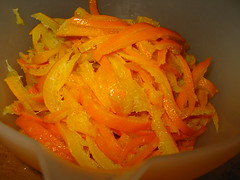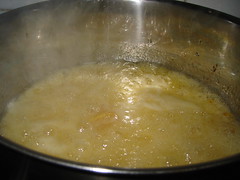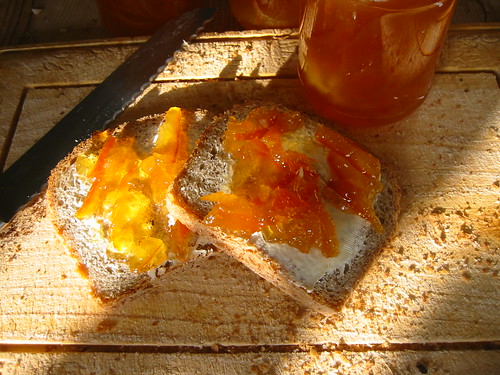A trip to the garden centre today turned up some end of season Seville Oranges. They looked in good order so we bought some and I'll be making marmalade this year after all. Here's the recipe I always use, as excellent now as it ever was.
=========== First published Jan 2008 =============
Marmalade is a peculiarly British thing. The French have an orange jam but it's nothing like the robust, slightly bitter, jellied spread that Brits adore with their breakfast toast.
January is the month of Seville oranges and, since due to an oversight, I'm in the UK at the moment I'm not sure if they're in the French shops or not but here, we made a special trip to a local supplier to secure our stocks for this year's marmalade.
The method I've used for longer than I care to remember is an adaption of a recipe from Farmhouse Cooking, a book of the TV series from way back in the 1970s. I looked it up again as research for this post and was surprised to discover just how far I've deviated over the years. The original recipe calls for a pressure cooker which I don't have and 50% more sugar than I use. Still, the reason I started using it was because the fruit is cooked whole, which in my opinion is a really sensible way to go about it, preserving all the juice and making slicing the peel into shreds easy peasy.


So for 7 or so jars of marmalade you'll need about 7 Seville oranges, a lemon, 1.7 litres water (that's three pints!) and 2kg sugar.
You'd be hard put to find a recipe for marmalade that doesn't include a lemon. It's really not necessary if you've got proper bitter Sevilles but I've decided I quite like the lift a small amount of lemon peel gives to the finished product so if I have one handy then I usually include it. The total weight of fruit I used was 1.2 kg.
Scrub the fruit really well, especially around the stem end, then put it into a really big saucepan (I make jam in a 9 litre pan) with the measured water. You should have just enough water to submerge the fruit although as it tends to float it won't look as if it's enough. Bring to a simmer and cooked, covered, for about 45 minutes or until the fruit is completely soft. If you have a pressure cooker and you want to do it that way then reduce the water by a tad, and cook for 20 minutes at 15 pounds.
Remove the fruit from the hot liquid keeping the water in the pan, drain (reserve the drips and return to the pan) and allow to cool for a while. The next stage can be done while the oranges are hot but it's dangerous work. A hour's cooling should be sufficient but you can leave them overnight if necessary.
Cut the fruit in half and scoop out all the seeds and pulp with a spoon. Put the scooped out bits back into the saucepan with the reserved liquid. Bring this back to a gentle simmer for 15 minutes while you chop the peels as you prefer. I usually do long thick shreds but you can cut it as thick or thin as you like. A cross cut to bring the shreds into cubes can be good and makes spooning the marmalade out of the jar and spreading a bit easier.
When the pot of water and seeds has had its simmer, strain the whole lot through a nylon sieve or jelly bag to remove the seeds. You can rub the pulp through to collect all the orange flesh you like although for a sparkly clear marmalade you shouldn't really squeeze too hard. You should be left with a couple of pints of richly orange flavoured and pectinated liquid.
Put the liquid and the sugar back into the pan and stir well to dissolve the sugar. Then add in the peel and over a gentle heat bring everything back to a boil stirring continuously as you do.
Boil hard for 10 minutes, you shouldn't need more time than that and test for a set on a cold plate. Remove from the heat and divide into your sterile warmed jars. A jam funnel is really useful because of the shreds of peel which can be wayward about going into their pots. Use a ladle and fill all the jars one ladle at a time, this gives the preserve time to cool and stops all the peel rising to the top as it sets. Seal while hot.

2 comments:
I concern the preservative on the skin. How to erase it all?
It's a good point anonymous. The trouble is that Seville oranges are usually in such short supply that people have to take what they can get, it's not much point in me recommending organically grown, unwaxed fruit even though that would be preferable.
What I do is soak the fruit for an hour in warm water with a little detergent in it, swilling them around from time to time. Then throw that water away and wash the oranges again under running water, using a small vegetable brush. I pick off any stem left and make sure to get the bristles of the brush into any folds or crevices. It may not be perfect and perhaps I will die of it eventually but these fruit are really only grown for making into preserves either homemade or in factories. If the pesticide burden was very high they would be unsaleable in the commercial market.
Post a Comment